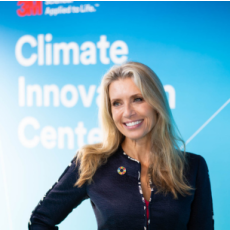How does 3M leverage cutting-edge materials science and technology to address climate change, focusing on decarbonization, energy efficiency, and waste reduction?
3M is a diversified industrial company that's been around for more than 100 years, founded in Minnesota with products like sandpaper, and later innovations around wet and dry sandpaper and adhesive tapes.
Today, we have over 50,000 products across a broad range of portfolios, from consumer products to safety and industrial, transportation, electronics, and many other spaces. We consider ourselves a materials science and technology company. We have 49 technology platforms, ranging from adhesives to abrasives. We recently added two new sustainability focused technology platforms: Circular Materials and Climate Technology in addition to Sustainable Design. Circular Materials integrates our ongoing efforts to advance the circular economy through material and process innovations, while Climate Technology reflects our capacity to accelerate climate solutions by scaling high-potential innovations in materials science.
We think it's critically important for companies like 3M to commit to climate action and to act with urgency. As a global manufacturer, we recognize our opportunity to implement existing solutions while continuing to develop new science-based technologies and work with our customers to implement them. We've been involved in generating a report called the State of Science Insights. Our data shows that 84% of people around the world believe that science can play an essential role in fighting climate change. We're super excited about this space. It's central to what we do as a diversified global manufacturer.
We continue to drive lower emissions across 3M's operations and foster collaboration with others to intensify our commitment to climate innovation solutions. By leveraging advanced materials science, we help drive decarbonization through our diverse portfolio, enabling the development of products that consumers and companies can use to tackle some of the world's most pressing climate issues.
One of our recent product launches at CES was the world's first self-charging protective communications headset. The headset converts outdoor and indoor light into clean, continuous energy using a patented solar cell technology called Powerfoyle™ that recharges a built-in lithium-ion battery.
By working with partners like Exeger, we can help power the future of consumer electronics, skipping the need to buy, replace, and recycle batteries.
You hinted at circularity and the circular economy. Tell me about your initiatives, particularly promoting the circular economy, and how sustainability is incorporated into new products like the Scotch-Brite sponge.
At 3M, we think about sustainability through three pillars: decarbonization and climate, advancing communities, and driving a circular economy. Science drives 3M's innovation, and since 2019, every new product 3M launches must have a sustainability value commitment. This commitment helps transform our products and, by extension, businesses and industries worldwide.
We have goals around using less packaging and reducing virgin fossil-based plastics by redesigning products and processes including shifting to recycled and bio-based plastics. As of Q1 2024, we've reduced our virgin fossil-based plastics use by over 76 million pounds, working towards our reduction goal of 125 million pounds by the end of 2025.
Scotch-Brite® Greener Clean™ is a great example of our initiatives, as it’s made with recycled content and plant-based materials while maintaining superior scrub performance. All Scotch-Brite® Greener Clean™ products come in recyclable packaging.
Today, we're doing things like eliminating plastic waste associated with shipping through innovations like our Scotch™ Cushion Lock™ Protective Wrap and our newly launched Padded Automatable Curbside Recyclable—or PACR—material. Cushion Lock is an expanding protective wrap made from 100% recycled paper, and PACR can run on automated packaging machines while offering padded protection and curbside recyclability.
I know you've been focusing on reducing greenhouse gas emissions by using renewable electricity. Tell me how this has progressed and what your goals are for further reductions and increased renewable energy usage.
3M was a leader in launching annual reporting around greenhouse gas emissions back in 2002. Since then, we've reduced our global emissions (scope 1 and 2) by over 80%. As of Q1 2024, this includes a 48.6% reduction in scope 1 and 2 emissions since 2019. Our company is rooted in science, and we approach our goals and commitments with a method we call the math, path, and plan approach. This means we know what we need to do, the timeline for it, and typically what it costs, allowing us to continually optimize our efforts.
In 2024, we've already achieved 56.9% renewable electricity across our global operations, surpassing our 50% goal for 2025. For scope 1 and 2 greenhouse gas emissions, we have committed to a 50% reduction by 2030, and we expect to deliver on that goal early.
How is sustainability integrated into 3M's culture, and how do you perceive the change in people's interest in sustainability, both among clients and employees?
Sustainability is deeply embedded in 3M's culture. We’ve conducted internal surveys that show our employees want to learn more about sustainability and how to bring it into their jobs. Recently, we launched a set of job function action guides to help 3M employees identify how they can integrate sustainability into their roles.
We're also seeing increased interest from customers. Our portfolio includes diverse solutions that help customers achieve their own sustainability goals through avoided emissions or lower impact products. As an upstream supplier to many of our customers, we support their scope 3 emissions efforts, reinforcing our role as a partner in their sustainability journey.
We believe in collaboration across sectors, engaging with groups like the TPG Rise Climate Fund, the UN Water Resilience Coalition, the Global Alliance for Sustainable Energy, and the United Nations Climate Change, among others.
Sustainability is part of who we are as a company and an employer. New employees often tell us that our sustainability record and Global Impact Report influenced their decision to join 3M.
Sustainability helps drive innovation, strengthens our relationships with stakeholders, and is an important piece of our employee brand.
Looking towards the future, what is your ideal vision for 3M in the next 10 years?
In the next 10 years, we see 3M playing an important role in transitioning to a greener, more sustainable world. There are four key themes to keep in mind: science, collaboration, urgency, and people.
For science, we leverage technology and innovation to accelerate progress, investing in new solutions and R&D to create opportunities for our operations and our customers. Collaboration is key, partnering to create greater impact across stakeholders, whether businesses, governments, civil societies, or individuals. We need to act with urgency to address climate change and limit negative impacts on communities. Finally, people are at the heart of this transition. We want to engage more individuals in sustainability, helping more people understand the issues and opportunities, and bringing their skills, knowledge, and passion to find solutions together. There's tremendous interconnectedness in what different individuals can offer, and we want to channel that to contribute to a sustainable future.






